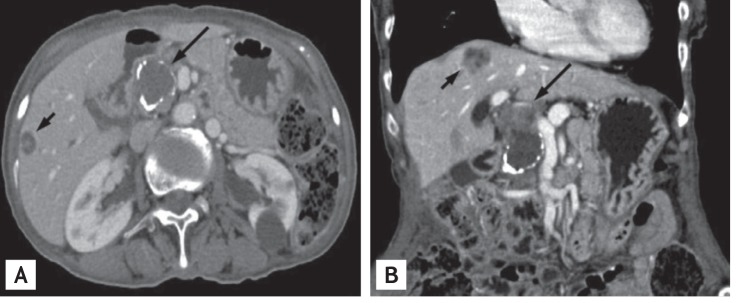Metastatic malignant solid pseudopapillary tumor of the pancreas
Article information
An 85-year-old Korean female presented with continuous weight loss. A physical examination revealed a soft, flat abdomen without a palpable mass or tenderness, and no enlargement of the superficial lymph nodes was detected. Her medical history was notable for diabetes. Routine laboratory tests and tumor markers including cancer antigen 19-9 (17.25 U/mL; normal range, < 34 U/mL) and carcinoembryonic antigen (CEA) (2.86 ng/mL; normal range, < 6.0 ng/mL) were within the normal ranges.
Abdominal computed tomography (CT) demonstrated a 3.7-cm cystic mass with calcification in the head of the pancreas (Fig. 1A). In addition, there was a 3.4-cm lobulating solid mass with necrosis above the cystic mass that was located along the hepatic hilum. A 2.9-cm solid mass and a 1.4-cm cystic mass were observed at the right side of the liver and appeared to be metastatic tumors of the pancreas (Fig. 1). An ultrasound-guided biopsy was taken from the solid mass at the liver dome.

Contrast enhanced abdominal computed tomography scans. (A) An axial scan shows a 3.7-cm sized cystic mass with peripheral curvilinear calcification in the head of pancreas (long arrow) and a 1.4-cm sized cystic mass with focal solid component that seems to be cystic metastasis in the liver segment 5 (short arrow). (B) A coronal scan shows a 3.4-cm sized lobulating solid mass with necrosis above the cystic mass which occupied along the hepatic hilum (long arrow) and a 2.9-cm sized solid mass that seems to be metastasis in the liver dome (short arrow).
Tumor cells near the portal area were relatively uniform, with light pink foamy cytoplasm (Fig. 2A). The possibility of adenocarcinoma from the pancreatic duct was excluded by negative CEA and mucin-1 staining. Neuroendocrine markers were positive for synaptophysin and negative for chromogranin. β-Catenin and CD10 immunochemical staining, which are known markers of most solid pseudopapillary neoplasms, were positive (Fig. 2B). The final diagnosis was a malignant solid pseudopapillary tumor (SPT) of the pancreas with metastasis to the liver.

(A) Light microscopy showing relatively uniform cells with light pink foamy cytoplasm and coordinated with pseudorosettes (H&E, × 100). (B) The tumor cells were stained with β-catenin which is known as the markers of most of solid psedopapillary neoplasm (× 100).
SPTs are quite rare tumors usually observed in young females. This case was a malignant SPT in an elderly female patient that was confirmed by histological and immunohistochemical studies but was initially suspected to be a pancreatic ductal adenocarcinoma.
Notes
No potential conflict of interest relevant to this article is reported.